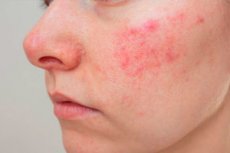
《科学报告》杂志最近发表的一项研究发现,酒渣鼻是一种常见的皮肤病,通常被认为仅仅是美容问题,但实际上它可能与几种相关疾病有关,包括黑色素瘤。
该研究使用了来自 TriNetX 平台的大量年龄和性别匹配队列(n = 244,888),其中包括白种人、黑人、亚洲人、阿拉斯加人和太平洋岛民。
研究结果显示,与先前的研究相反,酒渣鼻与视力障碍、代谢紊乱、关节问题和2 型糖尿病(T2D)的风险增加显著相关。
最值得注意的是,高加索人种亚群的黑色素瘤风险显著增加,而亚洲人种亚群则未观察到这一现象。这些种族差异或许可以解释先前研究中合并症报告的不一致。
尽管回顾性研究设计存在明显的局限性,但它证明有必要对这种常见但不太了解的疾病的病理进行进一步研究。
什么是酒渣鼻?为什么它这么长时间以来一直未被流行病学家关注?酒渣鼻是一种慢性皮肤病,主要表现为患者脸颊、下巴、鼻子和额头出现红肿和皮疹。该病最常见于30-50岁的女性,但任何年龄和性别的人都可能患上该病。
全球报告显示,凯尔特血统的人和皮肤白皙的北欧人更容易感染这种疾病,这些族群的患病率估计在 5% 至 10% 之间,而全球患病率估计为 1% 至 7%。
尽管早在 14 世纪末杰弗里乔叟的《坎特伯雷故事集》中就描述了酒渣鼻,甚至可能早在公元前 200 年忒奥克里托斯就描述了酒渣鼻,但人们对其的了解仍然很少。
尽管人们提出了导致该疾病的多种原因,包括紫外线照射、吸烟、饮酒、高温、运动、心理压力以及最常见的遗传因素,但这些原因从未得到科学证实。
近期研究发现,蠕形螨感染与酒渣鼻症状存在关联,因此口服抗生素成为出现症状时的首选临床干预措施。然而,这些干预措施只能暂时缓解症状,目前尚无长期治愈该疾病的方法。
本研究旨在回顾性地使用来自大型“真实世界”数据库(TriNetX 平台)的数据来确定酒渣鼻与包括恶性肿瘤在内的几种全身性疾病之间可能存在的相关性。
数据来自 2023 年 6 月至 7 月期间 21,913,235 名 TriNetX 注册患者,包括人口统计数据(尤其是年龄、性别和种族)和医疗记录(诊断、药物、实验室观察和基因组信息)。
研究的纳入标准包括诊断为国际疾病和相关健康问题分类 (ICD-10) 代码 L71(酒渣鼻)的患者,以及未诊断为酒渣鼻且年龄和性别匹配的同等数量的患者作为对照组。
在132,388例确诊为ICD-10代码L71(酒渣鼻)的患者中,122,444例(69.2%为女性)患者有年龄和性别匹配但未确诊酒渣鼻的患者,并被纳入本研究。这些患者中,82%为白种人,3%为黑种人,1.6%为亚裔,10%为族裔不详,其余为阿拉斯加人、印第安人、夏威夷人或太平洋岛民。
“虽然没有红斑痤疮的患者被诊断患有血管疾病的风险为 0.185,但患有红斑痤疮的患者这一风险增加到 0.336 [OR 2.234 (2.192, 2.276)]。”
与之前的报告相反,研究发现,酒渣鼻与心脏病(OR = 1.649)、2 型糖尿病(T2D;OR = 1.618)、代谢性疾病(OR = 3.165)以及眼部或关节疾病(OR = 4.164-4.801)的风险显著增加相关。
最令人担忧的是与酒渣鼻最密切相关的合并症,包括皮肤肿瘤(包括恶性黑色素瘤;OR = 6.031)。
在对伴有皮肤肿瘤的红斑痤疮患者进行亚组分析中,我们不仅发现非黑色素瘤皮肤癌 [C44;OR 5.550 (5.345, 5.763)] 的风险增加,而且还发现恶性黑色素瘤 (C43) [OR 4.468 (4.144, 4.818)] 的风险增加。鉴于红斑痤疮患者中恶性黑色素瘤的风险急剧增加,我们对该亚组患者进行了 Kaplan-Meier 生存分析。在时间窗结束时,患有和不患有红斑痤疮的患者群体的生存概率分别为 92.51% 和 97.71%。风险比 (HR) 为 3.286 (95% CI 3.101, 3.481),如果恶性黑色素瘤患者同时患有红斑痤疮,其死亡率更高 (p = 0.059)。
总体而言,这项研究首次令人信服地将酒渣鼻与多种合并症联系起来,其中一些合并症(黑色素瘤和心脏病)是危及生命的。
尽管仅使用回顾性数据和 ICD-10 代码存在明显的局限性,但该研究强调了酒渣鼻的重要性以及对这种看似无害的疾病进行进一步研究的必要性。

